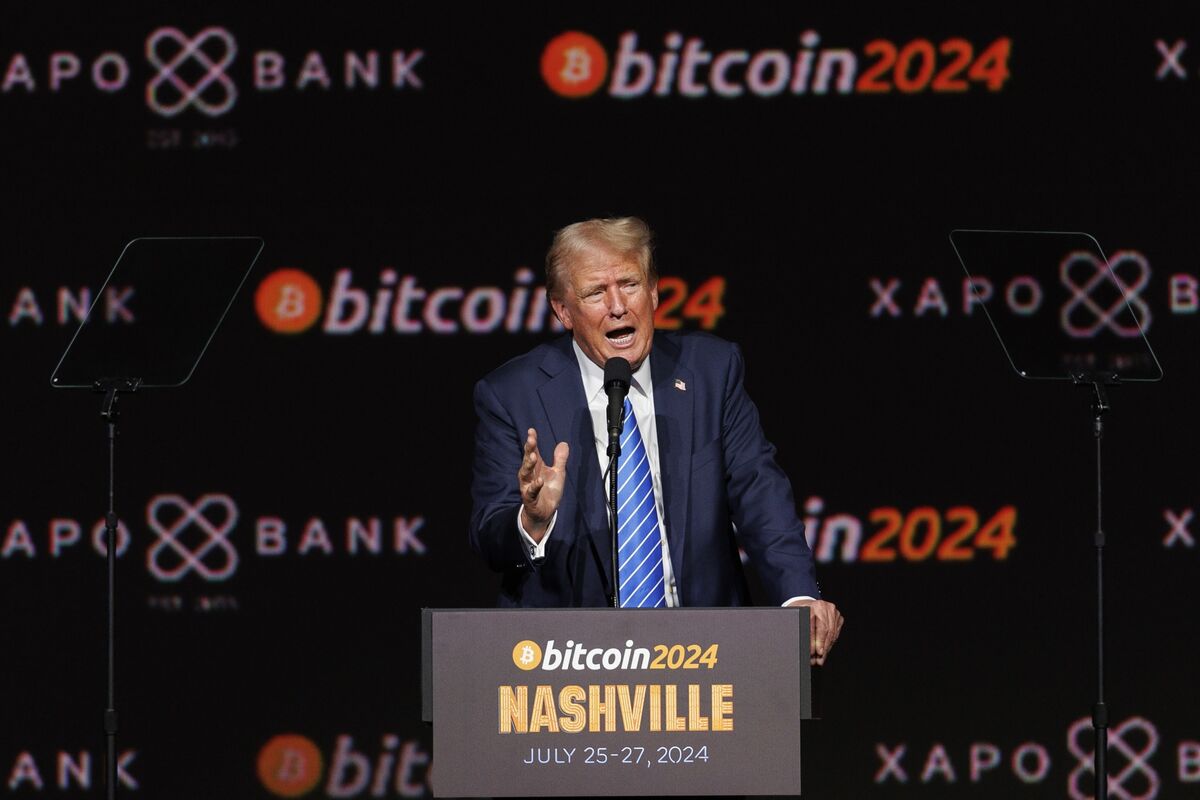Bitcoin
Grayscale Unveils Bitcoin Mini Trust ETF

Bitcoin Currency
Grayscale Investments The Bitcoin Mini Trust began trading on Wednesday with a 0.15% expense ratio, offering a lower-cost option for bitcoin exposure in the market.
The Mini Trust, which has the symbol BTC and trades on NYSE Arca, is structured as a spin-off of the Grayscale Bitcoin Trust (GBTC). New shares will be distributed to existing GBTC shareholders with the fund contributing a portion of its bitcoin holdings to the new product. According to a company press releaseBTC’s S-1 registration statement became effective last week.
“The Grayscale team has believed in the transformative potential of Bitcoin since the initial launch of GBTC in 2013, and we are excited to launch the Grayscale Bitcoin Mini Trust to help further lower the barrier to entry for Bitcoin in an SEC-regulated investment vehicle,” said David LaValle, Senior Managing Director and Head of ETFs at Grayscale.
The Bitcoin Mini Trust’s debut comes amid growing interest in ETFs based on the current price of the two largest cryptocurrencies by market cap, bitcoin and ether. Spot bitcoin ETFs have generated nearly $18 billion in inflows since the first ones began trading on Jan. 11, though GBTC has lost nearly $19 billion in assets.
This fund differs from other funds because it is a conversion of an existing fund and has a 1.5% fee, the highest among spot bitcoin products that have received SEC approval this year.
Mini Bitcoin Trust Low Fee
On a Post X On Wednesday, Bloomberg senior ETF analyst Eric Balchunas noted the Bitcoin Mini Trust’s “lowest fee in the category…”
“[Important] to recognize how incredibly cheap 15bps is — about 10x cheaper than spot ETFs in other countries and other vehicles,” Balchunas wrote, adding that this pricing strategy reflects the competitive nature of the U.S. ETF market, which he referred to as the “ETF Terrordome.”
“This is what Terrordome does to fund [cost]. It reaches 1.5% [and] end in 0.15%, how to go from [a] country club to the jungle. But that’s why all the flows are here, investor paradise,” he noted.
Read more: Spot Bitcoin ETF Inflows Hit Daily High of Over $1 Billion
Bitcoin was recently trading at around $66,350, virtually flat since U.S. markets opened on Wednesday.


Grayscale also offers two spot Ethereum ETFs, the Grayscale Ethereum Trust (ETHE) and the Grayscale Ethereum (ETH) Mini Trustwhose performance is based on ETHE. ETHE outflows exceeded $1.8 billion in its first six days of trading, while ETH added more than $181 million in the same period, according to Farside. The remaining seven ETFs generated about $1.2 billion in inflows.
The story continues
Read more: Spot Ethereum ETFs Approved to Start Trading
Permanent link | © Copyright 2024 etf.com. All rights reserved
Bitcoin
Bitcoin (BTC) Price Drops Below $65K After FOMC as Middle East Tensions Rise

Cryptocurrencies fell sharply on Wednesday as rising geopolitical risks captivated investors’ attention following the conclusion of the Federal Reserve’s July meeting.
Bitcoin (BTC) fell to $64,500 from around $66,500, where it traded following Federal Reserve Chairman Jerome Powell’s press conference and is down more than 2% in the past 24 hours. Major altcoins including ether (ETH)sunbathing (SUN)Avalanche AVAX (AVAX) and Cardano (ADA) also fell, while Ripple’s XRP saved some of its early gains today. The broad cryptocurrency market benchmark CoinDesk 20 Index was 0.8% lower than 24 hours ago.
The liquidation happened when the New York Times reported that Iran’s leaders have ordered retaliation against Israel over the killing of Hamas leader Ismail Haniyeh in Tehran, raising the risk of a wider conflict in the region.
Earlier today, the Fed left benchmark interest rates unchanged and gave little indication that a widely expected rate cut in September is a given. The Fed’s Powell said that while no decision has been made on a September cut, the “broad sense is that we are getting closer” to cutting rates.
While digital assets suffered losses, most traditional asset classes rose higher during the day. U.S. 10-year bond yields fell 10 basis points, while gold rose 1.5% to $2,450, slightly below its record highs, and WTI crude oil prices rose 5%. Stocks also rallied during the day, with the tech-heavy Nasdaq 100 index rebounding 3% and the S&P 500 closing the session 2.2% higher, led by 12% gains in chipmaker giant Nvidia (NVDA).
The different performances across asset classes could be due to traders’ positioning ahead of the Fed meeting, Zach Pandl, head of research at Grayscale, said in an emailed note.
“Equities may have been slightly underutilized after the recent dip, while bitcoin is coming off a strong period with solid inflows, while gold has recovered after a period of weakness,” he said.
“Overall, the combination of Fed rate cuts, bipartisan focus on cryptocurrency policy issues, and the prospect of a second Trump administration that could advocate for a weaker U.S. dollar should be viewed as very positive for bitcoin,” he concluded.
UPDATE (July 31, 2024, 21:30 UTC): Adds grayscale comments.
Bitcoin
Donald Trump’s Cryptocurrency Enthusiasm Is Just Another Scam

Former US President Donald Trump spoke at the Libertarian National Convention in May and lent his a strong support to crypto: “I will also stop Joe Biden’s crusade to crush crypto. … I will ensure that the future of crypto and the future of bitcoin is made in the US, not taken overseas. I will support the right to self-custody. To the 50 million crypto holders in the country, I say this: With your vote, I will keep Elizabeth Warren and her henchmen out of your bitcoin.”
Former US President Donald Trump spoke at the Libertarian National Convention in May and lent his a strong support to crypto: “I will also stop Joe Biden’s crusade to crush crypto. … I will ensure that the future of crypto and the future of bitcoin is made in the US, not taken overseas. I will support the right to self-custody. To the 50 million crypto holders in the country, I say this: With your vote, I will keep Elizabeth Warren and her henchmen out of your bitcoin.”
Trump continued to court the cryptocurrency industry in the months that followed; he he appeared at the Bitcoin 2024 Conference in Nashville this week, along with independent presidential candidate Robert F. Kennedy Jr.’s parting words to Trump — “Have fun with your bitcoin, your cryptocurrency and whatever else you’re playing with” — were less than enthusiastic, but the industry itself remains packed with ardent Trump supporters.
This turnaround came as a surprise, given Trump’s previous strong opposition to cryptocurrency. When Facebook was floating its Libra cryptocurrency in 2019, Trump tweeted: “I am not a fan of Bitcoin and other cryptocurrencies, which are not money, and whose value is highly volatile and based on thin air.” Former national security adviser John Bolton’s White House memoir, The Room Where It Happened, quotes Trump as telling Treasury Secretary Steven Mnuchin: “Don’t be a trade negotiator. Go after Bitcoin.” [for fraud].” In 2021, Trump counted Fox Business that bitcoin “just looks like a scam. … I want the dollar to be the world’s currency.”
Why the change? There doesn’t seem to be any crypto votes. Trump’s “50 million” number comes from a poorly sampled push survey by cryptocurrency exchange Coinbase which claimed 52 million cryptocurrency users in the United States starting in February 2023. But one survey A survey conducted last October by the US Federal Reserve showed that only 7% of adults (about 18.3 million people) admitted to owning or using cryptocurrencies — down from 10% in 2022 and 12% in 2021. Many of these people are likely wallet owners who were left holding the bag after crypto plunged in 2022 — and are not necessarily new fans.
What Trump wants from the cryptocurrency industry is money. The cryptocurrency industry has already raised more than US$ 180 million to run in the 2024 US elections through his super PACs Fairshake, Defend American Jobs and Protect Progress.
Fairshake spent $10 million on taking Rep. Katie Porter in the primary battle for Dianne Feinstein’s California Senate seat by funding Porter’s pro-crypto rival Adam Schiff. This put $2 million to knock out Rep. Jamaal Bowman in the Democratic primary for New York’s 16th District in favor of pro-crypto George Latimer. In the Utah Senate Republican primary, Rep. John Curtis defeated Trent Staggs with the help of $4.7 million from Defend American Jobs. In Alabama’s House District 2, the majority of campaign expenses came from the cryptocurrency industry.
Fairshake is substantially financed by Coinbase, cryptocurrency issuer Ripple Labs, and Silicon Valley venture capital firm Andreessen Horowitz, or a16z. Silicon Valley was awash in cryptocurrencies during the 2021 bubble, and a16z in particular continues to promote blockchain startups to this day — and still holds a huge amount of bubble crypto tokens that he wishes he could cash in on.
Many in Silicon Valley would like an authoritarian who they think will let them run wild with money — while bailing them out in tough times. Indeed, Trump promised Bitcoin 2024 participants that he hold all bitcoins that the United States acquires. (Never mind that it is usually acquired as the proceeds of crime.) Silicon Valley explicitly sees regulation of any kind as its greatest enemy. Three a16z manifestos — “Politics and the Future” It is “The Techno-Optimist Manifesto” and 2024 “The Small Tech Agenda—describe co-founders Marc Andreessen and Ben Horowitz’s demands for a technology-powered capitalism unhindered by regulation or social considerations. They name “experts,” “bureaucracy,” and “social responsibility” as their “enemies.” Their 2024 statement alleges that banks are unfairly cutting off startups from the banking system; these would be crypto companies funded by a16z.
Trump’s vice presidential pick, Senator J.D. Vance, is a former Silicon Valley venture capitalist. He was once employed by Peter Thiel, who bankrolled Vance’s successful 2022 Senate run; Vance has been described as a “Thiel creation”. He has increased support for the Trump ticket among his venture capital associates. Vance is a bitcoin holder and a frequent advocate of encryption. He recently released a draft bill to review how the Securities and Exchange Commission (SEC) and the Commodity Futures Trading Commission (CFTC) control crypto assets. In 2023, he circulated a bill to prevent banks from cutting out cryptocurrency exchanges.
Minimal regulation has been tried before. It led to the wild exuberance of the 1920s, which ended with the Black Tuesday crash of 1929 and the Great Depression of the 1930s. Regulators like the SEC were put in place during this era to protect investors and transform the securities market from a jungle into a well-tended garden, leading to many prosperous and stable decades that followed.
Crypto provides the opposite of a stable and functional system; it is a practical example of how a lack of regulation allows opportunists and scammers to cause large-scale disasters. The 2022 Crypto Crash repeated the 2008 financial crisis in miniature. FTX’s Sam Bankman-Fried was feted as a financial prodigy who would perform economic miracles if you just gave him carte blanche; he ended up stealing billions of dollars of customers’ money, destroying the lives of ordinary people, and is now in a prison cell.
U.S. regulators have long been concerned about the prospect of cryptocurrency contagion to the broader economy. Criminal money laundering is rampant in cryptocurrency; even the Trump administration has made rules in December 2020 to reduce the risk of money laundering from crypto. Meanwhile, the crypto industry has persistently tried to infiltrate systemically risky corners of the economy, such as pension funds.
Four U.S. banks collapsed during the 2023 banking crisis, the first since 2020. Two of them, Silvergate Bank and Signature Bank, were deeply embedded in the crypto world — Silvergate in particular appears to have collapsed directly from its heavy reliance on FTX and failed a few months after that. Silicon Valley Bank was not involved in crypto but collapsed due to a run on the bench due to panic among venture capital deposit holders, particularly Thiel’s Founders Fund.
Project 2025the Heritage Foundation mammoth conservative wish list The plan, which Trump and Vance have both endorsed and tried to distance themselves from at various times, emphasizes the importance of party loyalists, noting especially financial regulation. The plan recommends replacing as much of the federal bureaucracy as possible with loyalists and “trusted” career officials rather than nonpartisan “experts.” Vance defended in 2021 that Trump should “fire every mid-level bureaucrat, every civil servant in the administrative state” and “replace them with our people.” Loyalty will likely trump competence.
Crypto is barely mentioned directly in Project 2025 — suggesting it has little active support among the broader conservative coalition. But near the end of the manifesto is a plan to dismantle most U.S. financial regulations and investor protections put in place since the 1930s, suggesting the exemption the crypto industry seeks from current SEC and CFTC regulations.
Bitcoin, the first cryptocurrency, started as an ideological project to promote a strange variant of Murray Rothbard’s anarcho-capitalism and the Austrian gold-backed economy—the kind we abandoned to escape the Great Depression. Crypto quickly co-opted the “end of the Fed” and “establishment elites” conspiracy theories of the John Birch Society and Eustace Mullins. It’s a way for billionaire capitalists like Thiel, Andreessen and Elon Musk to claim they’re not part of the so-called elite.
If a second Trump administration were to limp along with financial regulators and allow cryptocurrencies to have free rein, it could help foster the collapse of the U.S. economy that bitcoin claimed to prevent. But Trump is more likely to be happy to take the crypto money and run.
Bitcoin
Trump’s Bitcoin (BTC) Reserve Plan Seen as Just a ‘Small Token Stash’

Donald Trump’s recent promise to create a “strategic national stockpile of Bitcoin” may not turn out to be as big a commitment as the hype surrounding the announcement makes it seem.
“Trump’s proposal is extremely modest,” said George Selgin, director emeritus of the Center for Monetary and Financial Alternatives at the Cato Institutea Washington-based public policy group. “It doesn’t have much economic implication.”
Bitcoin
Bitcoin Gets Political as US Government Mulls Airdrops

Last week’s Bitcoin Nashville conference dominated cryptocurrency news headlines — largely due to former U.S. President Donald Trump’s campaign speech (and many promises), as well as Senator Cynthia Lummis’ call for a national “Strategic Bitcoin Reserve.” (We have the bill.)
We walked around the event for four days as we struggled to cover all the news, and took plenty of photos. Bitcoin LARP, anyone?
U.S. Sen. Cynthia Lummis, a Republican from Wyoming, with a copy of her bitcoin reserve account at the Bitcoin Nashville conference on Saturday, July 27. (Danny Nelson/CoinDesk)
RESERVING JUDGMENT:Details of last weekend’s Republican calls for a “strategic national stockpile of bitcoin.” Trump, the party’s presidential candidate, has suggested using the government’s existing holdings of just over 200,000 BTC as the “core” of a new reserve. Wyoming Senator Cynthia Lummis has proposed going even further, possibly building it up to 1 million BTCor about 5% of the cryptocurrency’s maximum supply.
Lummis said on stage at Bitcoin Nashville that the plan could eventually “wipe out” the national debt – $27 trillion, at last check! – but didn’t really explain how this would work, “beyond the basic math that increasing U.S. government wealth would generally equate to reducing debt,” as CoinDesk’s Jesse Hamilton said:. Questions have arisen on social media about whether the government really had rights to keep the existing treasuryobtained primarily through seizures and losses associated with criminal activities; in other words, any stolen assets may at some point need to be returned to their rightful owners.
There has also been considerable speculation about what exactly did Lummis mean when she said, “We will convert excess reserves in our 12 Federal Reserve banks in bitcoin over five yearsor if the economics or legality of anything remotely close to it were even feasible. George Selgin, an economist at the conservative Cato Institute, wrote in X that he had “heard from someone in Senator Lummis’ office” who clarified that the plan was actually just to buy about $64 billion worth of bitcoins using balances created simply revaluing the gold at Fort Knox. CoinDesk obtained a draft bill which actually outlines a plan to revalue the Federal Reserve’s gold certificates while setting aside $6 billion of any net profits the U.S. central bank might generate over the next five fiscal years—with the giant caveat that the Fed has been lately losing money at a record pace.
Fun fact: The bill offers a provision for how the US government would handle any airdropped tokens.
Taking things to a higher level, the The Wall Street Journal Editorial Board concluded that “if cryptocurrencies truly are a libertarian vehicle for investing free from political whims, then they should be traded on their own, without government help.”
Bitcoin Nashville Conference in Pictures: Orange Athena, Pink Suits, Polymarket Giveaways, Trump Song
Lightning protocol engineer Lisa Neigut leading an instructional game called “Bitcoin LARP” at last week’s Bitcoin Nashville conference (Bradley Keoun)
Check out our photo blog from last week’s Bitcoin Nashville conference: “Surreal doesn’t even begin to describe the combination of images collected at last week’s festival honoring the oldest and largest cryptocurrency, punctuated by former US President Donald Trump’s pro-crypto campaign speech to an adoring crowd.”
Featuring, in order of appearance: David Tse, Lisa Neigut (above), Adrián Eidelman, Fred Thiel, Justin Sun (not exactly, but sort of), Robin Linus, Jeremy Rubin, Liam Eagen, Weikeng Chen, Andrew Poelstra, Casey Rodarmor, Erin Redwing, Cathie Wood, Michael Saylor, Ron Paul, Donald Trump.
Last week’s top picks from our Protocol Village column, highlighting the main updates and news about blockchain technology.
The Irys project will feature permanent data storage as well as “term data books” (Irys)
1. Irisdescribing himself as a provenance layer for data storage, has announced that it will transition to a new Layer 1 network with the launch of a “programmatic data chain that combines data storage and execution.” According to the team: “Through IrysVM, which is fully EVM-compatible, developers can take advantage of efficient and cost-effective real-time data manipulation. This approach simplifies development processes, improves scalability, and ensures stable and predictable prices for data transactions and storage.” Ecosystem partners building on Irys Layer 1 include Berachain, Eclipse, Injective Labs, Livepeer, Linea, IoTeX, Gateway.fmLit Protocol, NodeKit, Olas, Snapchain, BeraLand and YEET.” Founded in 2021, Irys began its journey as Bundlr, a scaling solution for permanent data storage on Arweave.
2. Router protocola project built using Cosmos blockchain technology, said Tuesday it has launched the mainnet of a new blockchain designed for “chain abstraction” – a concept adopted by many protocols with the goal of making the blockchain user experience more uniform. To make the new Router Chain more uniform across chain interactions, it will focus on lowering “development barriers and streamlining the development of dApps that can seamlessly interact with multiple blockchains and aggregate liquidity from any chain,” according to a press release shared with CoinDesk.
3. Blackbird Labsthe restaurant loyalty platform founded by Resy and Eater co-founder Ben Leventhal, announced the Blackbird Pay launcha system that will allow participating restaurants to accept cryptocurrency payments. The new payments platform expands Blackbird’s mission by allowing consumers to pay for their meals using the cryptocurrency $FLY. The tokens can be earned as loyalty points for dining at participating restaurants or purchased in the Blackbird app using the popular Coinbase USDC Stablecoin.
4. The developers of Theoreticaldescribed as an “AI agent base layer”, published its official project whitepaperintroducing the key aspects of their network and outlining its benefits for developing collectives of advanced AI agents. According to the team: “Using a decentralized model, Theoriq will leverage smart contracts to ensure transparency and accountability, while maintaining flexibility to ensure its network will continue to adapt as AI continues to advance in complexity.”
5. DashThe cryptocurrency project focused on paymentsis releasing the Evolution update on July 29, described as “its most important update” to date, featuring a new sidechain. According to the team, the project aims to “enable indexed decentralized storage and decentralized applications.” According to a blog postThe sidechain “is run by EvoNodes, which also secures the legacy Dash chain. It uses the account-based model (single addresses hold balances), as opposed to the UTXO model (multiple addresses hold coins, or UTXOs) of the Core chain. It uses a heavily modified derivative of the Tendermint (Cosmos) consensus called Tenderdash. The main differences between Tenderdash and Tendermint are that the Dash version runs on the same block, meaning you don’t have to wait for the next block after writing new data to query it.”
Hyperbolic CEO Jasper Zhang and co-founder Yuchen Jin (Hyperbolic)
The benchmark CoinDesk 20 Index of blue-chip digital assets returned 3.3% during the month through July 30, nearly matching July returns for gold but slightly outperforming the Standard & Poor’s 500 index of U.S. stocks.
MTD returns through July 30. (Tracy Stephens/CoinDesk Indices)
XRPThe token used in Ripple Labs’ XRP Ledger dominated the month’s big gainers, rising 32%, followed by Solana’s SOL at 20%. Bitcoin was the only other cryptocurrency in the green, up 3.8% month-to-date.
MTD returns through July 30. (Tracy Stephens/CoinDesk Indices)
-

 Ethereum12 months ago
Ethereum12 months agoEthereum Posts First Consecutive Monthly Losses Since August 2023 on New ETFs
-

 Regulation12 months ago
Regulation12 months agoCryptocurrency Regulation in Slovenia 2024
-

 News12 months ago
News12 months agoNew bill pushes Department of Veterans Affairs to examine how blockchain can improve its work
-

 Regulation12 months ago
Regulation12 months agoThink You Own Your Crypto? New UK Law Would Ensure It – DL News
-

 Regulation12 months ago
Regulation12 months agoUpbit, Coinone, Bithumb Face New Fees Under South Korea’s Cryptocurrency Law
-

 Regulation12 months ago
Regulation12 months agoA Blank Slate for Cryptocurrencies: Kamala Harris’ Regulatory Opportunity
-

 Regulation12 months ago
Regulation12 months agoBahamas Passes Cryptocurrency Bill Designed to Prevent FTX, Terra Disasters
-

 Regulation12 months ago
Regulation12 months agoIndia to Follow G20 Policy for Cryptocurrency Regulation: MoS Finance
-

 News1 year ago
News1 year ago“Captain Tsubasa – RIVALS” launches on Oasys Blockchain
-

 Ethereum1 year ago
Ethereum1 year agoComment deux frères auraient dérobé 25 millions de dollars lors d’un braquage d’Ethereum de 12 secondes • The Register
-

 News12 months ago
News12 months agoEU supports 15 startups to fight online disinformation with blockchain
-

 News1 year ago
News1 year agoSolana ranks the fastest blockchain in the world, surpassing Ethereum, Polygon ⋆ ZyCrypto












